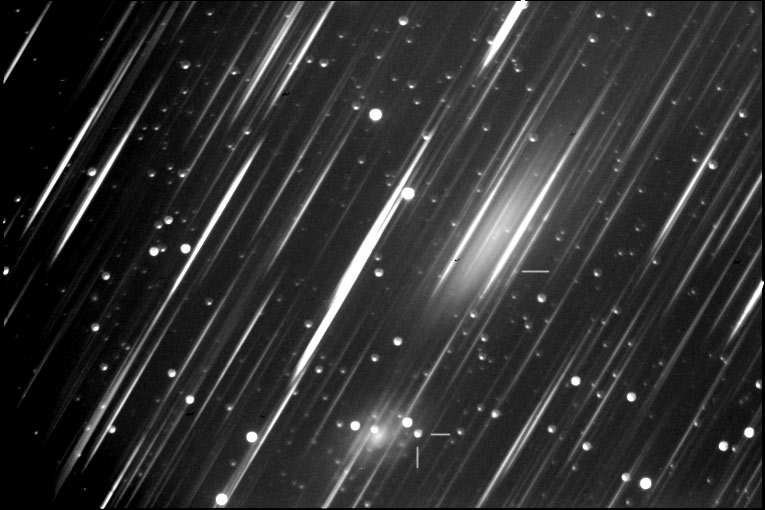
My idea to obtain a supernova spectrum dates four years back. In summer 2000 I tried a new toy, a Rainbow Optics grating on several stars to record their spectra. Calibration of the spectra took a while, because I had to develop some software to process the data and, of cause I had no experience. Compared to those stars a typical bright supernova, that appears in another galaxy, is apparently several hundred times fainter. No hope to record these ancient photons and the idea was frosted then.
With detection of supernova SN2004dj in galaxy NGC2403 the chance came suddenly in the beginning of August 2004. With 12mag it was promising bright. The brightest supernova since 1993! The absolute unfavourable position of the galaxy, at its lowest elevation right north in the sky was a bit disappointing. Weather conditions were terrible and as usual I was not prepared for such an event.
First tests on August 5, showed no spectrum for the tiny star at all. I had to reduce the length of the spectra to record some of the colorful photons. That meant, I had to reduce the distance between CCD and grating, I had to shorten the nosepiece of my camera, the location where the grating screws in. Manfred Ott helped me with his lathe to do the job. Weather forced me to wait more than a week to try the new adapter. It worked, but two nasty foreground stars masked the most interesting parts of the spectrum. Doing it better was prevented by clouds.
In the third attempt I finally succeeded. One hour of total integration time gave me the image below. For calibration from pixels to Angstrom I made a spectrum of 7.4mag Wolf-Rayet star WR136, which is the central star of NGC6888, the Crescent Nebula. It shows prominent emission lines of known wavelength. Indicated are positions for h-alpha (6563A) and h-beta (4686A).

Image and first oder spectra of NGC2403 and SN2004dj at indicated positions. Date 2004/08/23 0:15UT. 15 images of 4 min integration time were added. The second index marks also a faint disturbing foreground star. Camera SBig ST-8E, binning 2x2, telescope Newton 8inch f/4.6

Detail from image above, rotated 59.6 deg CW. This type of spectroscope has strong field curvature, therefore one does not focus on stars but on spectral lines.
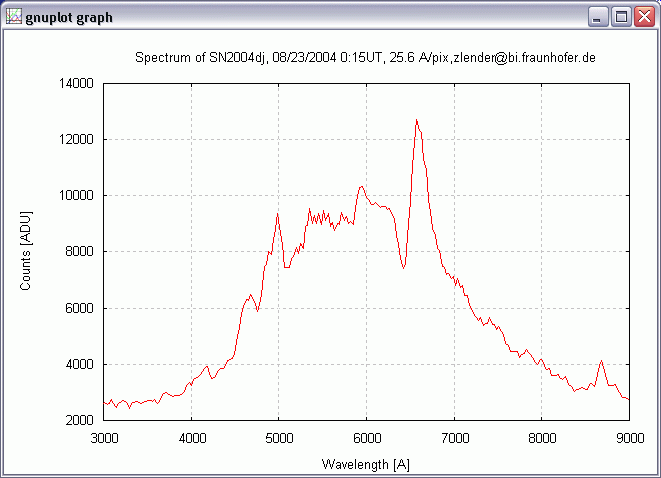
Spectrum of SN2004d, 08/23/2004j. The peak at 5000 Angstrom is not a spectral feature. It results from the image of a foreground star.
So now, what can we say about the supernova from this spectrum?
The only prominent feature I can see is the rather strong emission line of h-alpha
at 6563 Angstrom. This feature, respectively the presence of hydrogen, classifies
the supernova as Type II, because Type I sn have no hydrogen at all in their
spectra. The depletion on the left side, next to the strong emission peak is
also due to H-alpha. This blue shifted light, or more specific the absorbed
light at this wavelength, originates from the explosive layers that were
blown out in our direction. Astronomers have designated the whole emission-absorption
profile of this type of line as P-Cygni profile, because it was well studied
as a spectral feature of this star. It also allows us to give a more specific
classification of the supernova as Type II-P, because only these sn have strong
P-Cygni profiles. The difference in wavelength between minimum and maximum allows
us further to estimate the velocities which are related to such an explosive
event. My estimate from four spectra for H-alpha gives v= (6800  500) km/s in approach for the shells, where v = c
500) km/s in approach for the shells, where v = c  .
.
More spectra could be obtained on September 2nd, 7th and 8th. I present the results as a gif-animation here. In this way it is easier to compare spectral features and identify noisy parts.
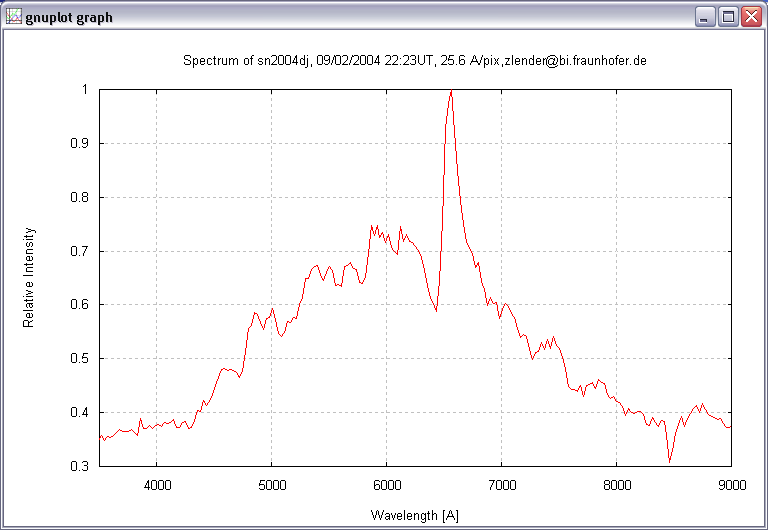
Spectrum of SN2004dj, 09/02 and 09/07/2004. Besides the dominating H-alpha line at 6563A more features can be identified. Compare my results with a professional spectrum from DDO of this supernova from August 17th http://astro.u-szeged.hu/~sn/html/2004dj.html
October 21, 2004
Meanwhile the supernova has faded considerable to 15mag. So it is a challenge to take a spectrum of such a dim object at half-moon. (Lightcurve: http://www.astrosurf.com/snaude/im_2004/2004_4/CurveBVRI_2004dj1.jpg)
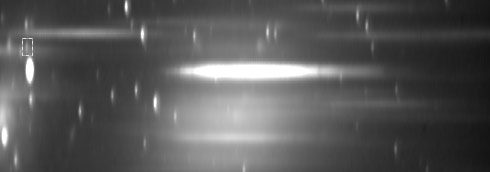
Diffuse NGC2403 at left edge and supernova SN2004dj surrounded by a small square. Spectra go to the right. Total integration time was nearly 3 hours.
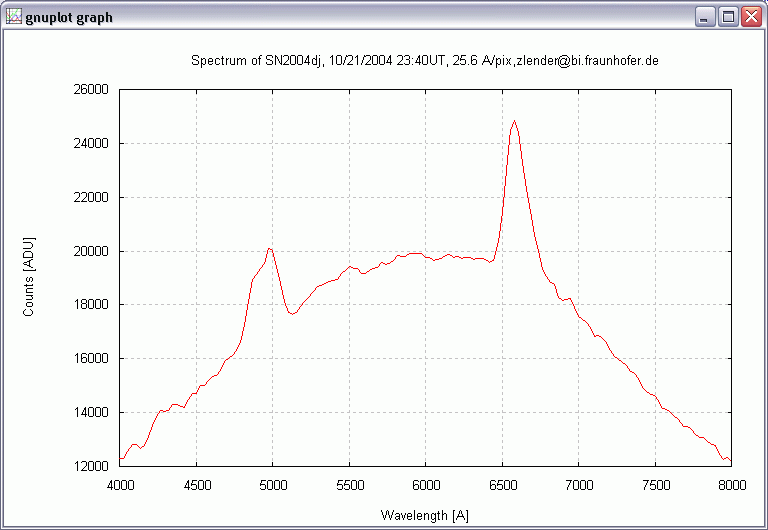
Raw spectrum of SN2004dj, calibrated for wavelength only. The only features here are emission lines of H-alpha and H-beta. Astonishing is that the pronounced P-Cygni profile of H-alpha is gone.
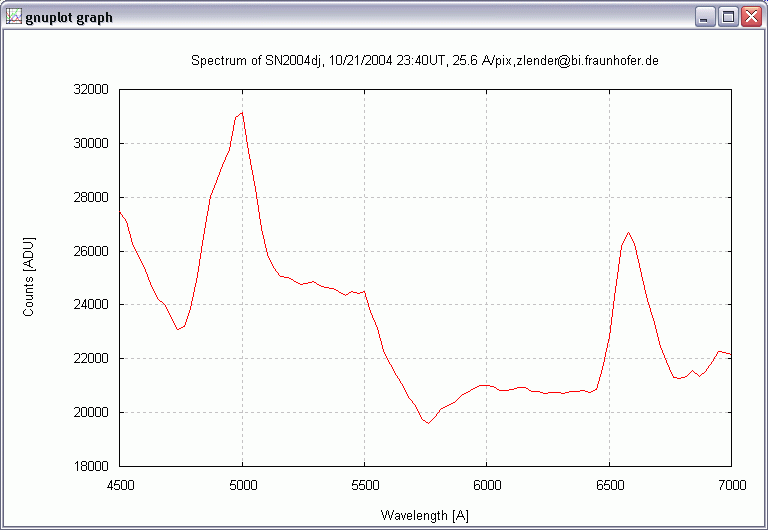
If we take spectral response of the CCD and atmospheric transmission into accout, the spectrum looks quite different. If we interpret the deep absorption at 4750A as blueshifted H-beta we are able to estimate the explosive velocity again as v=300000*(4861-4750)/4861=6850 [km/s]. A really satisfying result.
A very well illustrated and animated explanation of P-Cygni profiles can be found at Daniel Kasen's site: http://panisse.lbl.gov/~dnkasen/tutorial/
You can train your skills in supernova classification at: http://suspect.nhn.ou.edu/~suspect/
Comments welcome, contact:
![]()